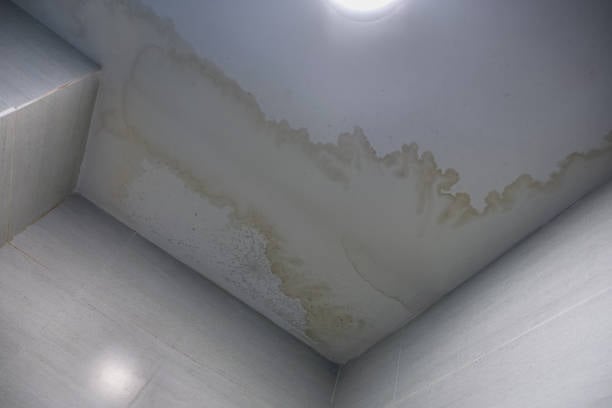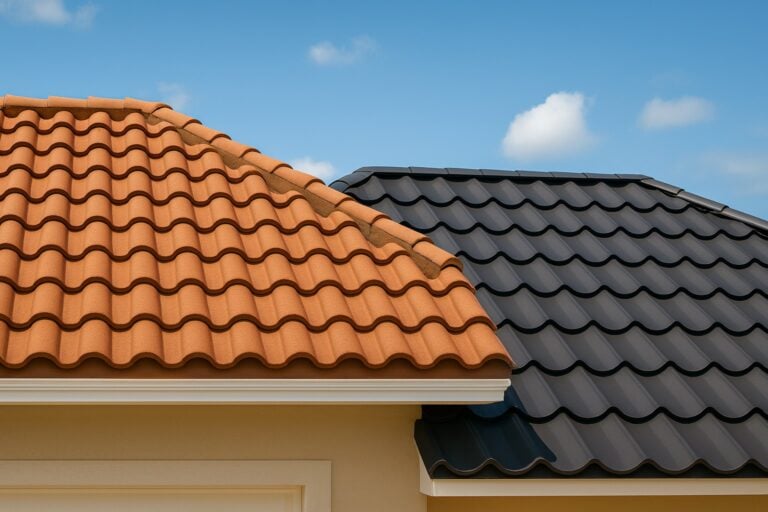We understand how alarming it can be when water begins seeping through your ceiling, staining walls, or dripping from the attic. In Riverview, FL, when you work with Steadfast Roofing, you get comprehensive diagnostics and repairs so your home stays safe and dry. Below, we lay out the most common reasons residential roofs leak, how to find the source, how to repair, and how to prevent future damage.
What We Mean by a Roof Leak
A roof leak isn’t just water dripping from the ceiling. It can manifest as:
- Wet stains on plaster or drywall
- Damp or soft spots in the attic or ceiling boards
- Mold, mildew, or musty smell
- Inflamed roof sheathing or insulation
- Interior warping or paint peeling
Leaks may appear only during heavy rain, snow melt, strong wind, or even some time following those events. Sometimes leaks are intermittent. Identifying the cause quickly is essential to avoid structural damage, mold, or rot.
Primary Causes of Residential Roof Leaks
Below are the most frequent culprits we find—and what to inspect for:
| Cause | What Happens | Key Clues / Symptoms |
| Aging Roof Materials | Over time, roofing shingles or tiles lose granules, crack, warp, curl, or become brittle. Wear and tear degrade the waterproofing capability. | Shingles are curled up, missing granules, and have dark spots or large patches. Roof older than typical life expectancy for its material (e.g., asphalt shingle ~ 20–30 years). |
| Missing or Damaged Shingles or Tiles | The rubber (or sealant) around pipe boots or roof-vent collars deteriorates from UV, weather, thermal expansion/contraction. Small cracks for water ingress develop. | Visible missing pieces, cracks in tiles, uplifted edges, especially after storms. Interior stains align under those areas. |
| Flashing Failures at Roof Penetrations | Seal around chimneys, skylights, vent pipes, dormers, or where the roof meets the walls. Flashing (metal or rubber) may be missing, loose, rusted, cracked, or improperly installed. | Water stains around chimneys, vents, dripping by skylights, and dampness around vent boots: flashing visible gaps, corrosion, loose seams. |
| Vent Pipe Boots or Vent Seals Degrading | Debris builds up, causing ponding; water overflows or backs up under roofing materials. Water can saturate fascia or back up into the roof deck. | Water dripping near vent pipes; cracks or splits in rubber boots; sealing that has peeled back. |
| Clogged or Poorly Functioning Gutters and Downspouts | Overflowing gutters, visible debris, water staining beneath the roof edge, or sagging gutters and fascia. Interior leaks close to eaves or roof edges. | Sagging roof deck, soft spots when walking in the attic, visible daylight through the roof boards. Underlayment may be deteriorated around penetrations. |
| Damaged or Missing Underlayment / Roof Deck Issues | Leaks that coincide with valley lines, debris settled in valleys, and misaligned flashing at intersections. | Underlayment is the secondary defense layer beneath shingles. If it is torn, improperly installed, or deteriorated, water may penetrate the decking. Decking may also rot, warp, or crack. |
| Valleys, Dormers, & Roof Intersections | Where two roof planes intersect or where valleys are formed, water flow is heavier. If valley flashing fails or valleys get debris, leaks happen. Dormers add complexity. | Moisture stains, damp insulation, mold or mildew in the attic; sweating pipes; roof sheathing discoloration. No visible external roof damage but interior dampness. |
| Skylights or Chimneys & Masonry Damage | There is water around the skylight frame, chimney crown cracks, and deteriorated mortar or mortar joints. Water staining near the chimney interior. | Skylights can crack or seal fail; masonry chimneys can have deteriorating mortar joints; chimney caps may be missing or damaged. |
| Condensation & Ventilation Issues | High winds, hail, heavy rain, snow, or ice storms can damage roof components, displace shingles, tear flashing, or break seals. Trees are falling, or branches are damaging the roof. | Poor attic ventilation or insulation can cause condensation buildup. Moist warm air meeting cold surfaces causes moisture, which can mimic leak symptoms. |
| Extreme Weather & Storm Damage | New damage after a storm; missing granules; dents or impact marks; debris on the roof; branches leaning; sudden leak after heavy rain or wind. | High winds, hail, heavy rain, snow, or ice storms can damage roof components, displace shingles, tear flashing, or break seals. Trees falling or branches damaging the roof. |
How We Trace the Source of a Leak
To fix a leak properly, we must locate its true origin, which can be far from where water appears inside the home. Our process usually includes:
- Interior Inspection
We examine ceilings, attic spaces, insulation—looking for stains, water trails, mold. We inspect the roof decking from inside to find light penetration or moisture. - Exterior Roof Survey
We check all roof surfaces, looking for missing or damaged shingles/tiles, cracked flashing, seal around penetrations, and the condition of underlayment visible at edges or valleys. - Water Test
If the source isn’t apparent, we conduct controlled water tests: spraying sections of the roof (with funnels, hoses) while someone inside watches for drip points. - Attic Ventilation & Insulation Assessment
We check for proper air intake and exhaust vents, ensure insulation doesn’t block airflow, and measure moisture levels. - Damage Depth Assessment
Check the roofing deck or sheathing for rot, and note if boards are soft to walk on; inspect the substructure if leaks have been longstanding. - Review Installation History & Roof Age
Original installation quality matters: was flashing done properly, were roof penetrations sealed, is the design suited to the local climate, etc. A roof at or beyond its service life tends to have multiple failure points.
Repair Methods & Solutions
Once we’ve identified what’s causing the leak, we can apply various repair techniques. We ensure fixes are durable and compliant with roofing standards in southern coastal climates (like central Florida, which deals with high heat, humidity, and storms).
| Problem | Repair Action |
| Cracked or missing shingles/tiles | Replace missing shingles. Realign or remove warped ones. Match materials for size, style, and slope. |
| Damaged flashings (chimney, valleys, hips, ridges) | Remove old flashing; install new flashing, often metal (galvanized, aluminum, copper) with proper sealing; ensure counter-flashing and step-flashing are properly layered. |
| Replace gaskets or glazing; seal the skylight frame; replace or reflash the surrounding flashing; check the roofing around it. | Replace vent boot; use durable materials; properly seal and flash around pipe; ensure adequate overlap. |
| Skylight leak | Remove compromised roofing material; repair or replace underlayment; replace sheathing or deck boards if rotted; ensure a water barrier is under the shingles. |
| Underlayment or decking damage | Clear debris; adjust alignment; ensure downspouts direct water away from the foundation; install gutter guards if needed. |
| Storm damage/impact repair | Gutter/downspout cleaning & repair |
| Improve ventilation & insulation | Add or improve soffit vents, ridge vents, attic fans; ensure insulation is adequate but does not block vent airflow; control condensation. |
| Storm damage / impact repair | Replace impacted shingles or tiles; repair damaged flashing; remove fallen trees or debris; reinforce or upgrade weak areas. |
Cost Ranges & Considerations
Repairs vary greatly depending on extent, materials, access, roof steepness, and location.
- Simple fixes (vent boots, small flashing patches, and replacing a few shingles) result in lower costs.
- Major repairs (multiple damaged flashing areas, large deck replacement, large skylight, damaged structure) run substantially higher.
- In the Riverview, FL area, salt exposure, tropical storms, and high UV may mean more frequent inspections and more robust materials (e.g., corrosion-resistant flashing).
Insurance coverage may apply depending on the cause (storm damage vs wear and tear). Retaining documentation of inspections and repairs can help with claims.
Preventative Measures: How We Keep Leaks From Happening
To extend your roof’s life and minimize leaks, we recommend implementing these preventative strategies:
- Regular Roof Inspections: at least twice a year (after winter and after summer), and after significant storms.
- Keeping Gutters and Valleys Clean: remove leaves and debris to ensure water flows off properly.
- Ensuring proper attic ventilation and insulation helps prevent condensation damage and protects roof sheathing.
- Quality Flashing & Sealant Upkeep: check all penetrations, and reseal or replace any failing flashing.
- Use High-Quality Materials: weather-resistant sealants, durable shingles, rustproof metals, etc.
- Trimming Overhanging Trees: prevent damage from branches and reduce debris on the roof.
- Prompt Repairs: address small issues before they grow. Minor water stains may hide bigger damage beneath.
How Long Do Roofs Last & When Replacement Is Inevitable
Some leaks are a symptom of general roof failure. We consider total replacement when:
- The roof is at or past its expected life for the material.
- Multiple major components (deck, underlayment, flashing) are damaged.
- Repair costs exceed 50-70% of replacement cost.
- Structure under the roof (rafters, supports) is damaged or compromised.
Choosing full replacement with upgraded materials often offers better value long-term than frequent patching.
Typical Leak Diagnostic Checklist We Follow
- Check the attic when it’s raining to see where water enters.
- Trace the drip path since water can travel before appearing in the interior ceiling.
- Inspect flashing around chimneys, pipes, and skylights.
- Look over roof valleys and ridges.
- Inspect shingles/tiles: lift, check nails, and granule loss.
- Check gutters/downspouts and ensure drainage away from the home.
- Evaluate ventilation and insulation for condensation issues.
Why Local Climate Matters
In regions like Florida, we contend with:
- High UV exposure: degrades sealants and rubber boots faster.
- Hurricanes/tropical storms: high winds, hail can damage shingles and tiles.
- Heavy rainfall/monsoons: test the waterproofing and flashing during intense rain.
- Salt air (if near coast): accelerates metal flashing corrosion, rust.
We choose materials and installation methods that suit these conditions, to help your roof survive longer and leak less.
Conclusion
Leaks come from weak points—age, faulty installation, deteriorated materials, weather, and poor maintenance. We at Steadfast Roofing thoroughly evaluate, correctly repair, and guide preventative strategies to ensure the roof over your head remains reliable. Taking immediate action when you spot symptoms and investing in quality repair materials are your best defenses. If you suspect your roof is leaking, promptly contact a professional for an evaluation to minimize damage and preserve your home’s integrity.
Read one of our latest blogs: “Can You Replace a Tile Roof with Metal in Florida? Understanding HB293 for Homeowners”.



